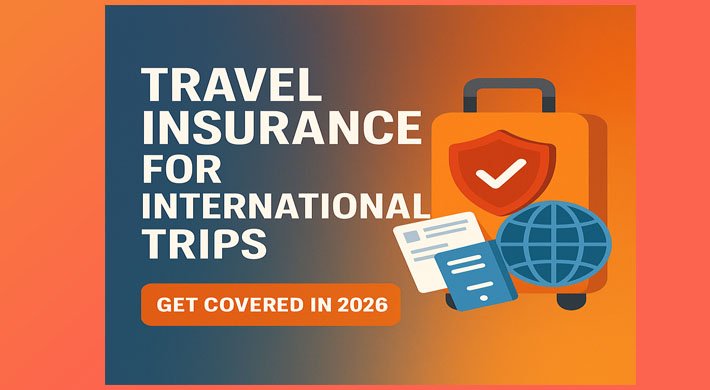Ad Details
-
Ad ID: 96977
-
Added: July 5, 2025
-
Views: 6
Description
Traveling internationally in 2026? Don’t board that plane without locking in the right international travel insurance. Whether you’re a student heading overseas or a digital nomad on the move, the right coverage could save you thousands—and a lot of headaches.
Here’s how to choose the best plan for your trip, based on your destination, length of stay, risk level, and personal needs.
✅ 1. Understand What Travel Insurance Actually Covers
Not all travel insurance is created equal. Before buying a policy, make sure it includes:
-
Trip cancellation/interruption: Reimburses you if your plans change due to illness, weather, or emergencies.
-
Emergency medical coverage: Covers treatment if you get sick or injured abroad.
-
Evacuation and repatriation: Covers emergency transport to a hospital or back home.
-
Lost/delayed baggage: Compensation for lost luggage or long delays.
-
24/7 assistance: Crucial when navigating a crisis in another time zone.
High-value policies bundle all these into a single plan. Always read the fine print.
2. Special Consideration for Student Travel Insurance
If you’re studying abroad in 2025, student travel insurance is your safety net. Look for:
-
Long-term coverage (often 6–12 months)
-
Mental health and wellness support
-
Academic disruption reimbursement (tuition or housing loss)
-
Flexible cancellation for visa or admission delays
Pro tip: Many universities offer group plans—compare them with private insurers to ensure you’re not overpaying or under-covered.
3. Match Your Coverage to Your Destination
Where you’re going matters. Here’s why:
-
USA, Japan, and Switzerland have high medical costs—opt for higher health coverage.
-
Remote or politically unstable regions? Prioritize emergency evacuation.
-
Schengen Zone in Europe requires proof of travel insurance for visa approval (at least €30,000 in medical coverage).
Choose a plan tailored to the risks and requirements of your location.
4. Consider the Length and Type of Trip
Short vacation? Extended stay? Business trip? Backpacking for a year?
-
Single-trip insurance is ideal for one-off vacations.
-
Multi-trip (annual) plans are great for frequent travelers.
-
Gap-year or long-term plans are designed for extended overseas stays.
Make sure your trip coverage matches your itinerary—and can be extended if plans change.
For Travel Insurance Providers Listing on VyaparGrow
“Offer Travel Insurance? Get Free Leads on VyaparGrow!”
List your services today and reach international travelers, students, and frequent flyers—100% free.
👉 Post Your Travel Insurance Ad Now
5. Compare Providers (Don’t Just Buy the First One)
Use comparison tools like Squaremouth, InsureMyTrip, or VisitorsCoverage to review:
-
Customer reviews
-
Coverage limits
-
COVID-19 policies
-
Exclusions and claim process
Top providers for 2025 include:
-
World Nomads (great for adventure travelers)
-
Allianz Travel Insurance
-
SafetyWing (popular with students and digital nomads)
-
IMG Global
Always get quotes from at least three providers.
Side‑by‑Side Travel Insurance Comparison
| Feature | World Nomads | SafetyWing | Heymondo |
|---|---|---|---|
| Ideal for | Adventure travelers (250+ activities) (nomadicmatt.com) | Budget digital nomads/students | Students seeking comprehensive, upfront cover |
| Medical coverage | Varies by plan; includes emergency care, evacuation | $250,000 basic, global including COVID | ~$200,000–$250,000; medical bills paid upfront |
| Adventure sports coverage | Covers >250 activities, including high-risk ones | Limited; essential plan may exclude high-risk sports | Usually excludes sports—focus on medical/trip benefits |
| Trip cancellation/interruption | Included in Standard and up; flexible options | Interruption and baggage only; no cancellation | Trip cancellation & interruption covered |
| Baggage coverage | Up to $500–$1,500 per item; gear covered | ~$3,000 loss; limited electronics coverage | $3,000 baggage; electronics ($1,500); no deductible |
| Deductible | Typically $0–varies; depends on plan | $250 per claim | $0 |
| Price | Mid-range; multiple tier options | ~$56 for 4 weeks (age 10–39); $196 for 60+ | ~$202 for 3 months student policy |
| Post-travel coverage | Doesn’t cover home country | Covers 30 days in-home after 90 abroad | Mainly coverage abroad |
| Claims & customer experience | Mostly praised; claims can be slow; some negative reviews | Generally smooth but occasional claim rejections | Highly rated for upfront payments and student focus |
🎓 Best Pick for Students
If you’re a student, stay-abroad healthcare is key:
-
Budget-conscious → SafetyWing: Affordable, deductible $250, covers essentials but lacks travel cancellation.
-
Priority on zero deductible and upfront care → Heymondo: $0 deductible, medical bills paid directly, plus strong trip benefits. A top pick for international students
When to Choose Which
-
For adventure travelers (scuba, trekking, biking): World Nomads offers unmatched adventure coverage.
-
For long-term digital nomads or multi-destination students: SafetyWing offers flexible, low-cost protection—even extended in-home coverage.
-
For students prioritizing cost-free care and comprehensive benefits: Heymondo is the standout choice.
Pro Tips for 2026 Travel Insurance
-
Consider Cancel‑For‑Any‑Reason (CFAR) add‑ons—gaining in popularity due to climate uncertainties like wildfires
-
Buy insurance early, ideally soon after booking, to cover pre-existing conditions.
-
Always read the fine print, especially for coverage inclusions and exclusions tied to sports or gear.
6. Watch for These Red Flags
Avoid these common mistakes:
-
Skipping pre-existing condition clauses: If you have a condition, disclose it. Many policies offer a waiver if you buy early.
-
Assuming credit card travel insurance is enough: It usually isn’t.
-
Not reading exclusions: Adventure sports, pandemics, and protests may not be covered unless explicitly included.
Final Tips for Buying Travel Insurance in 2026
-
Buy early: You get more coverage if you purchase soon after booking.
-
Print and store digital copies of your policy and emergency numbers.
-
Understand the claims process before you need it.









Leave a Comment
Your email address will not be published. Required fields are marked. *